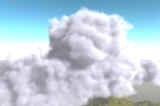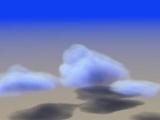|
|
|
|
-
 "Real-Time
Cloud Rendering" (pdf)
"Real-Time
Cloud Rendering" (pdf)
- Mark J. Harris and Anselmo Lastra, Eurographics 2001
- presents a method for realistic real-time rendering of clouds
suitable for flight simulation and games
- provides a cloud shading algorithm that approximates multiple
forward scattering in a preprocess, and first order anisotropic
scattering at runtime
- impostors are used to accelerate cloud rendering by exploiting
frame-to-frame coherence in an interactive flight simulation
- "Simulation of Cloud
Dynamics on Graphics Hardware" - site, (3
MB pdf)
- Mark J. Harris, William V. Baxter III, Thorsten Scheuermann,
Anselmo Lastra, 2003
- clouds are modeled using "partial differential equations describing
fluid motion, thermodynamic processes, buoyant forces, and water
phase transitions" !!
- uses "flat 3D textures" - 3D data laid out as slices tiled in
a 2D texture - to implement 3D simulations on the GPU
|
-
 "A
Real-Time Cloud Modeling, Rendering, and Animation System" "A
Real-Time Cloud Modeling, Rendering, and Animation System"
- J. Schpok, J. Simons, D. S. Ebert, C. Hansen, 2003
- describes the software package Swell, an interactive
cloud modeling tool, which produces "perceptually convincing volumetric
cloud models that can be used in interactive systems or exported
for higher quality offline rendering"
|
|
|
-
 "A
Simple, Efficient Method for Realistic Animation of Clouds" "A
Simple, Efficient Method for Realistic Animation of Clouds"
- Y.Dobashi, K.Kaneda, H.Yamashita, T.Okita, T.Nishita, Siggraph
2000
- proposes a simple and computationally inexpensive method for
animation of clouds
- realistic motion of clouds, shadows cast on the ground, and
shafts of light through clouds
- uses OpenGL for near-realtime rendering
|
-
 j.p.lewis j.p.lewis
- did some solid texture cloud studies (presented Siggraph
1989)
|
- Geoffrey Gardner
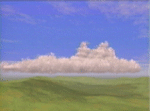
- as early as 1985, he was effective at turning simple ellipsoid
surfaces into cloud volumes
- Geoffrey Gardner, "Visual Simulation of Clouds,"
Computer
Graphics, 19, No. 3 (1985), pp. 297-304
- not much online information on him or his work
- Send in the Clouds (1990) and Forest Fire Simulation (1992)
- "Cumulous cloud development is simulated using fractal ellipsoids
to model the clouds. The ellipsoids are positioned and scaled
by a heuristic dynamic model based on the "parcel" theory, which
describes cloud development in terms of air bubbles heated by
external sources such as radiated terrain heat."
|
-
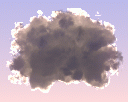 Ken
Musgrave Ken
Musgrave
- was a professor at GWU, then Director of Advanced 3D Research
at MetaCreations; now has his own company
Pandromeda
- page on
Modeling
Clouds
- goal is to combine realistic geometric models with a radiosity
solution for the illumination
|
|
|
- Paper at VRAIS '98:
- Authors : Unbescheiden,
Matthias and Trembilski, Andrzej
Title : Cloud Simulation in Virtual Environments
Abstract: In this paper we present a new method of simulation and
visualization of smoke and steam clouds in virtual environments.
We use a particle system approach but reduce the particle numbers
to decrease the computation and rendering times. Special care, however,
is taken for the presentation quality of the clouds. From every
viewing point (even within the clouds) the VE user will not have
the impression that the clouds are hollow polyhedrons, but rather
fuzzy objects.
- Trembilski worked on TriVis (below)
|
-
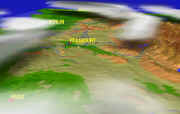 TriVis:
Artificial Realistic Clouds Modelled by Simulation Data TriVis:
Artificial Realistic Clouds Modelled by Simulation Data
- Visualizing artificial clouds with a naturalistic appearance
that are modelled directly and automatically by the simulation data
of the numerical forecast model
- In TriVis, fast and especially tailored fractal functions are
employed for the generation of realistic 2D and 3D clouds that can
be rapidly rendered by standard graphics hardware.
|
-
Fabrice Neyret at University of Toronto's
Dynamic Graphics Project (DGP)
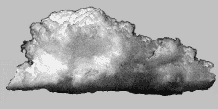
- Convective Cloud Simulation
keywords: atmospheric physic, animation, big hacks
I'm interested in simulating the formation and dynamics of convective
clouds, like the cumulus (which can be extended to smoke).
Beyond fluids local equations, that lead to costly 3D systems to
solve, physicists characterize several
structures at various scales in fluids, and their interactions,
such as bubbles, jets, instabilities, waves, convective cells, vortices,
etc. The idea is to use directly this knowledge to generate convective
phenomena, like
cumulus clouds and billowing smoke are. This allows to separate
the scales: large bubbles account for large range air motion, while
waves and vortices lying on a bubble surfaces are just locally advected.
"I will sketch what a cloud is, especially a convective cloud like
the cumulus, and describe 'how this thing works'. I'll give a rough
idea about the local physics model that is usually used to achieve
costly, physically-accurate simulations. I will then show some heuristic,
high-level structures of various scales, like bubbles, instabilities,
vortices, turrets, and hot spots. These structures yield some (almost)
equation-free rules of thumb about how to animate a cloud."
|
-
Bryce (non-realtime 3D)
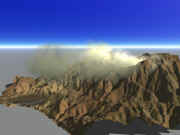
- latest version claims "artists can command clouds to roll by
as the sun sets"
- Bryce's "clouds" are only flat, continuous cloud layers
- many options are presented for haze, cloud height, frequency,
color, distribution, etc.
- more like clouds: a feature called "localized fog"
- consists of a object, such as a flattened sphere, with a "volume
material" applied
- by applying one of 37 supplied "cloud textures" and tweaking
"edge softness" and transparency, you can get a decently realistic
cloud puff
- the most impressive cloud sample is a single sphere, with a
grey marble solid texture and "edge softness" set to maximum
|
-
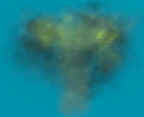 PyroCluster PyroCluster
- a MAX plugin from cebas Computer
- claims to do clouds, but rather does mostly steam and explosion
effects
- does allows shadows to be cast by, and cast onto, the cloud
effects
|
- TerraGen
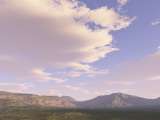
- cloud layers are shaded using the direction of the sunlight
- this gives the flat layers the appearance of being lit up correctly
in 3-D, resulting in a very convincing sky
- Hugo writes:
"The secret behind Terragen's beauty: rather than going for all
out brute force and mathematical accuracy, Matt just writes algorithms
that produce good results, rather than trying to exactly
model the physics. The clouds are essentially a beautiful bodge."
|
- Visidyne
CloudScape
-
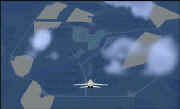 "provides
quantitative, radiometric, three-dimensional cloud rendering in
real time" "provides
quantitative, radiometric, three-dimensional cloud rendering in
real time"
- very military-oriented
- partnered with Paradigm
- component products:
- CloudGen creates databases describing the 3-D distribution
of particulate mass density
- CloudRad converts the 3-D mass density distributions into
radiometric databases that describe the cloud surfaces and their
radiative properties
- seems to be SGI-only
|
 Cloud
Cover tutorial by
Hugo Elias
Cloud
Cover tutorial by
Hugo Elias Generating
Procedural Clouds in real time on 3D HW (pdf) by Kim Pallister
Generating
Procedural Clouds in real time on 3D HW (pdf) by Kim Pallister
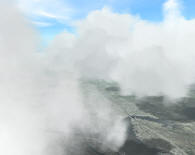
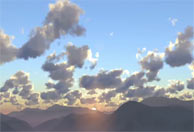 Simul software
Simul software 


 "A
Real-Time Cloud Modeling, Rendering, and Animation System"
"A
Real-Time Cloud Modeling, Rendering, and Animation System"